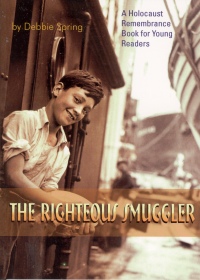| ________________
CM . . .
. Volume XII Number 7 . . . .November 25, 2005
excerpt:
The Righteous Smuggler is a worthy addition to “The Holocaust Remembrance Series” published by Second Story Press, which has also produced two much-admired books, The Underground Reporters by Kathy Kacer and Hana's Suitcase, by Karen Levine. Hendrik, a 12 year-old boy, is the son of a poor fisherman in Amsterdam, Holland. He narrates the story as his happy life is shattered with the invasion of the Nazis in 1940. Their reign of terror began immediately. His Jewish friends are expelled from school, and soon Jews are thrown out of their jobs and businesses. Hendrik describes his fears but also his revulsion of these actions. He defies the handful of his schoolmates who are enthused by the idea of discrimination and brutality. Every day new atrocities are committed. When deportations begin, Hendrik is frantic. His friend Malka, for whom he harbours a secret crush, is among those sent off to their death. He looks to his father and mother for guidance and action to assist the innocent people whose only crime is their religion. The course of action Hendrik and his parents follow is based on the courageous and humane actions taken by many non-Jews throughout the occupied countries. People were terrified of the Nazis but could not stand by when their friends and neighbours were being beaten or killed. In the face of arrest and certain death, they fed, clothed, hid and smuggled Jews out of the reach of the Nazi murderers. Hendrik's father risked his life by transporting Jews out onto the North Sea where they were transferred to another boat and smuggled to England. Just as events transpire in real situations of war, Spring's fictional account does not include perfect endings. The serendipitous nature of war is that the saints were just as liable to die as the people they were helping. Hendrik's father is killed by a collapsing building. Hendrik is consumed by grief, but the struggle leaves no time for mourning. A member of the resistance contacts him right at the graveside, and so Hendrik himself becomes a hero, taking over his father's boat and risking his life by smuggling men, women and children to safety. The conclusion to the book is satisfying and appropriate. Years after the war, Hendrik, now a grandfather, is being honoured at Yad Vashem, the institution established in Jerusalem to memorialize the six million Jews killed by Hitler and the 'righteous gentiles', as they are called, who sought to protect the persecuted. Hendrik is an ordinary boy with a decent heart, brought up by decent, thinking parents. Spring is to be congratulated for creating typical characters in a typical town setting. The variety of personalities and occupations give the young reader a realistic picture of life in 1940s Netherlands. The characters are well-drawn - ordinary people who displayed heroism of which they never could have imagined they were capable. The honours accorded them later in their years were also unexpected. When asked why they did what they did, the response was usually that it was the right thing to do. Their conscience was their guide; they had nothing to gain and everything to lose, but there was no choice in the matter. That was the answer given by a man who hid one of my own relatives. His wife and daughter were killed by shrapnel as they toiled in the farmyard while six people hidden in the attic of their tiny house survived the shelling around them. Yet the man and his remaining daughter remained true to their conscience, scrounging secretly to feed everyone without detection. The Righteous Smuggler is an important story, not just for its historical merit. It is an example to inspire young people, because, just like Hendrik, they never know what challenges they may meet in life. Highly Recommended Harriet Zaidman is a teacher-librarian in Winnipeg, MB.
To comment
on this title or this review, send mail to cm@umanitoba.ca.
Copyright © the Manitoba Library Association. Reproduction for personal
use is permitted only if this copyright notice is maintained. Any
other reproduction is prohibited without permission.
NEXT REVIEW |
TABLE OF CONTENTS FOR THIS ISSUE
- November 25, 2005.
AUTHORS |
TITLES |
MEDIA REVIEWS |
PROFILES |
BACK ISSUES |
SEARCH |
CMARCHIVE |
HOME |
